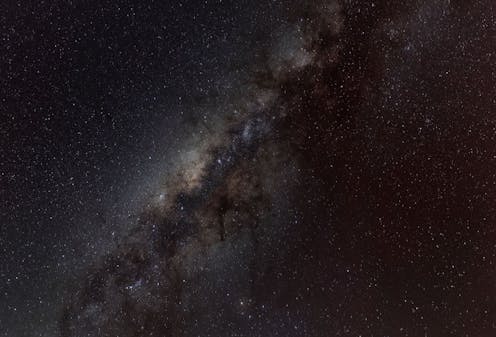Why is space so dark even though the universe is filled with stars?
- Written by Brian Jackson, Associate Professor of Astronomy, Boise State University

Even though that’s an amazingly long time in human terms, it’s short in astronomical terms. It’s short enough that the light from stars more distant than about 13 billion light years hasn’t actually reached Earth yet. And so the actual bubble around Earth that contains all the stars we can see only extends out to about 13 billion light years from Earth[13].
There just are not enough stars in the bubble to fill every line of sight. Of course, if you look in some directions in the sky, you can see stars. If you look at other bits of the sky, you can’t see any stars. And that’s because, in those dark spots, the stars that could block your line of sight are so far away their light hasn’t reached Earth yet. As time passes, light from these more and more distant stars will have time to reach us.
The Doppler shift
You might ask whether the night sky will eventually light up completely. But that brings me back to the other thing I told you to imagine: that all of the stars are not moving. The universe is actually expanding, with the most distant galaxies moving away from Earth at nearly the speed of light[14].
Because the galaxies are moving away so fast, the light from their stars is pushed into colors the human eye can’t see. This effect is called the Doppler shift[15]. So, even if it had enough time to reach you, you still couldn’t see[16] the light from the most distant stars with your eyes. And the night sky would not be completely lit up.
The Doppler shift, also known as the redshift, is a phenomenon in which light from objects that are moving away from an observer appears more toward the red end of the spectrum.If you wait even longer, eventually the stars will all burn out – stars like the sun last only about 10 billion years[17]. Astronomers hypothesize that in the distant future – a thousand trillion years from now – the universe will go dark, inhabited by only stellar remnants[18] like white dwarfs and black holes.
Even though our night sky isn’t completely filled with stars, we live in a very special time in the universe’s life, when we’re lucky enough to enjoy a rich and complex night sky, filled with light and dark.
Hello, curious kids! Do you have a question you’d like an expert to answer? Ask an adult to send your question to CuriousKidsUS@theconversation.com[19]. Please tell us your name, age and the city where you live.
And since curiosity has no age limit – adults, let us know what you’re wondering, too. We won’t be able to answer every question, but we will do our best.
References
- ^ Curious Kids (theconversation.com)
- ^ curiouskidsus@theconversation.com (theconversation.com)
- ^ Olbers’ paradox (lambda.gsfc.nasa.gov)
- ^ 200 billion trillion stars (theconversation.com)
- ^ I am an astronomer (www.astrojack.com)
- ^ astronomers like me (scholar.google.com)
- ^ here (theconversation.com)
- ^ a star 10 times farther away looks 100 times dimmer (hyperphysics.phy-astr.gsu.edu)
- ^ light years (exoplanets.nasa.gov)
- ^ a dozen stars (en.wikipedia.org)
- ^ 13 billion years old (starchild.gsfc.nasa.gov)
- ^ NASA/ESA/CSA/STScI/Handout from Xinhua News Agency via Getty Images (www.gettyimages.com)
- ^ 13 billion light years from Earth (science.nasa.gov)
- ^ moving away from Earth at nearly the speed of light (starchild.gsfc.nasa.gov)
- ^ Doppler shift (starchild.gsfc.nasa.gov)
- ^ you still couldn’t see (svs.gsfc.nasa.gov)
- ^ stars like the sun last only about 10 billion years (astronomy.swin.edu.au)
- ^ inhabited by only stellar remnants (en.wikipedia.org)
- ^ CuriousKidsUS@theconversation.com (theconversation.com)
Authors: Brian Jackson, Associate Professor of Astronomy, Boise State University

